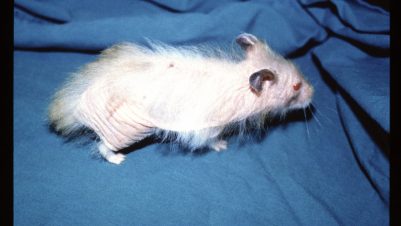Mucocutaneous pyoderma
is a rare disease seen in dogs. It
affects the lips and peri-oral skin
mainly, with lesions occasionally
found on the eyelids, vulva,
prepuce or
anus.
The cause
is unknown, although a bacterial
component is suspected due to the
response to antibacterial treatment.
Clinical findings
- Any breed, sex, age – German
shepherd may be predisposed. - Swelling erythema of the lips
initially. - Crusting and erosion with fissures
may develop later. - Depigmentation of
the lips may occur. - Care when examining
as the lesions are often
painful.
Diagnosis
- Lesions extending along the
length of the lips and involving the
commissures are very suggestive. - The main differential diagnosis is
lip fold pyoderma. There are no folds
with mucocutaneous pyoderma and
the lesions are more extensive. The two
conditions could co-exist, complicating
the diagnosis. - Other differential diagnoses include
early autoimmune diseases such as
pemphigus foliaceus or cutaneous
lupus, demodicosis, Malassezia
dermatitis, dermatophytosis and
epitheliotropic lymphoma.
The diagnosis can be made on
clinical grounds and response to
treatment.
The finding of cocci and neutrophils
in an impression smear of the lesions
is supportive. Histopathological examination is confirmatory.
Findings consist of epidermal hyperplasia, superficial crusting and a
lichenoid dermatitis with preservation
of the basement membrane. There is
a dermal infiltrate consisting mainly
of plasma cells with smaller numbers
of lymphocytes, neutrophils and
macrophages.
Treatment
- Apply an Elizabethan collar if the
dog is traumatising the lesions. - For mild cases a shampoo
containing chlorhexidine applied daily
for two weeks initially. - Mupirocin ointment applied twice
daily has been suggested, and found
to be very effective in some cases,
although dogs may lick ointments
and not tolerate touching of the lips.
The dog illustrated would not tolerate
topical treatment. - Systemic antibacterial treatment
is therefore often needed, and in this
case was four weeks of cephalexin at a
dose of 30mg/kg every 12 hours. This
achieved remission without relapse.
Relapse following treatment is
not uncommon, however, and can
be managed with topical treatment
in the early stages, with the aim of maintaining control if cure is difficult.
Although the lesions look inflamed,
glucocorticoids are not necessary with the above treatment and may hinder
the response.
Further reading
Hnilica, Keith A. (2011) Small Animal
Dermatology. A Color Atlas and Therapeutic
Guide. 3rd ed. pp57-58: Elsevier.







-1628179421-401x226.jpg)



